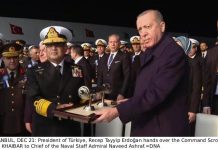By Zhou Renjie, People’s Daily
China is one of the countries that see the largest desertification areas with the largest population affected, and the most severe wind-sand hazards in the world.
It has made remarkable achievements in its combat against desertification, which comprises millions of touching stories of the Chinese people.
According to the results of the sixth national monitoring survey on desertification released at the end of 2022, China’s desertification and sandification areas had been on a decline for four consecutive monitoring periods, and for the first time, all provinces surveyed reported desertification and sandification reversals. This indicates that China has successfully curbed the expansion of desertification.
Desertification is a major ecological issue facing the world and remains one of the most pressing environmental problems.
For a long time, China has taken the prevention and control of desertification as an important strategic task and adopted a series of effective measures to tackle the problem.
It follows a philosophy that “lucid waters and lush mountains are invaluable assets,” carries out holistic conservation and systematic governance of mountains, rivers, forests, farmlands, lakes, grasslands and deserts, and strengthens ecological and environmental protection in all fields, regions, and processes.
As a result, the country has achieved remarkable progress in combating desertification and sandification, blazing a new trial of prevention and control with Chinese characteristics. It has realized a historic transformation from “sand forcing humans to retreat” to “trees forcing sand to retreat,” and built a virtuous circle of environmental protection and livelihood improvement.
China, though achieving phased results, is still in a critical period of desertification control from a long-term perspective.
Land desertification is caused by both humans and nature. To restore harmony between men and nature on degraded lands, more science-based guidance shall be provided for desertification control.
To optimize its control plans with dynamic changes in desertification, China launches a nationwide monitoring survey on desertification every five years, and a new annual dynamic monitoring activity in 2021.
So far, the country is working to implement projects including afforestation, desertification control, returning farmland to forest and grass, and tea-oil camellias planting. Last year, relevant departments for the first time reported afforestation plans with specific location information and assigned targeted afforestation tasks.
Desertification control is a long-term and arduous task that calls for efforts of the whole society and the wide participation of the people in control areas.
From Saihanba of Hebei province to Youyu county in Shanxi province, from Kubuqi Desert in Inner Mongolia autonomous region to Kekeya in Xinjiang Uygur autonomous region, the people in these places have made ceaseless efforts to fight desertification in the past decades.
Their motivation came from the spirit of resilience and perseverance, and help them find ways to shake off poverty while combating desertification.
According to statistics, 48 million tons of dried and fresh fruits are produced in China’s desert areas each year, accounting for about a quarter of China’s total production with a total annual output value of 120 billion yuan ($16.81 billion). These products have helped approximately 15 million people get rid of poverty. In key areas, over half of farmers’ net income is from the fruit business.
Synergetic promotion of economy and ecology under moderate utilization can mobilize people to widely join desertification control, advance large-scale land greening action, and build a strong ecological barrier.
Thanks to its constant efforts, China has taken the lead in the world to realize zero net land degradation. The country will work to consolidate its achievements, implement conservation measures, offer more scientific and technological support, and mobilize more social participation, so as to write new chapters of desertification control.














